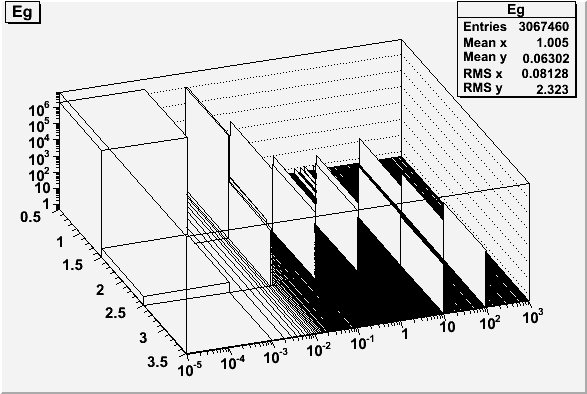HomeWork Simulations of Particle Interactions with Matter
Homework 1
1.) Mawell Boltzmann
Given the Maxwell -Boltzmann Distribution
a.) Show <v>
Show that
b.) Energy Fluctuation
Show that the energy fluctuation is
- Note
- = velocity fluctuation
2.) MC calculation of Pi
Calculate using the Monte Carlo method described in the Notes
3.) Histograms using ROOT
Homework 2
1.) Derive Rutherford Formula
Derive the Rutherford Scattering formula.
2.) EXN02 in GEANT
a.) Compile and run the default version of ExN02 in GEANT4
You can use a computer screen shot to prove you did this.
b.) Now make your own copy of it and change the target material
Homework 3
Download and install your own version of GEANT4
Use a screen shot to prove you did it.
Homework 4
1.) Use GEANT4 to simulate the calculation the energy loss of a ion through LH2. In class I showed an example for an incident 10 MeV electron. You need to pick another particle (proton, pion, ...) and a different energy. Compare your answer with the Triumf curve.
2.) Compute for the heavy charged particle you chose to simulate in problem 1. Use the particle's energy at one of the tracking steps and compare to what GEANT4 found.
Homework 5
1.) Show that the maximum energy transfered to thin absorbers for a relativistic head on collision is
- = momentum of incident heavy charged ion of mass
- = mass of target electron initially at rest
2.) Use GEANT4 to determine the Range of the particle chosen in Homework 4 through liquid hydrogen as a function of Energy.
Homework 6
1.) You need to lower the beam energy of 600 MeV protons to 400 MeV using a slab of copper. The density of the copper is 8.962 . Determine how thick the copper should be by integrating the stopping power curve:
Stopping Power of several particles through Copper as a function of energy is shown in this curve. File:StoppingPowerInCopper.pdf
2.) Alter GEANT4 example N02 to check your answer for problem 1 above. I expect you to hand in a screen shot showing GEANT4 tracking the proton from 600 MeV to 400 MeV.
3.) Find using GEANT4 for a 600 MeV proton traveling through a slab of copper. You will need to make the copper thick enough to stop the proton. Then output the stopping distance to a file which you can read into ROOT using some of the software we used for Homework 1's RNG problem.
Homework 7
Media:SPIM_BremE-Spectrum-Tantalum.pdf
Media:SPIM_LaTex_TemplateFile.txt
Homework 8
1.) Write a Paragraph (4 - 5 sentences) desribing the Simulation you would like to perform as your Project for this class. You will need to write a title. You will need to specify the reaction you will be simulating.
Homework 9
Homework 10
Homework 11
There are 2 parts to this homework. First you will compare relative rates for the PhotoElectric, Compton, and pair production physics processes using the same target you used in Homework 10. Second you will write another section of your project which describes the experimental results you are going to compare to using GEANT4.
1.) Compare Photoelectric, Compton and pair production rates relative to eachother using the same target used in the last Homework assignment (#10).
a.) first turn on all three physics processes for a gamma particle in the physics list.
b.) add variables to the output which can be used to identify which physics process is responsible for the event being written to the output file.
c.) Run the simulation so the incident photon energy spans energies from 100 eV to 10 GeV.
d.) Use ROOT to plot a 3-D representation of the Process type on one axis, the incident photon energy on the other axis and the number of counts along the z-axis.
A bad example of such a plot for a 30 cm long Argon gas target is given in the file
Yours will have better labels
Hint:
->Draw("ProcesID:Egamma","","lego");
2.) Add another section to your project report which describes the experimental measurements you will be using to compare to GEANT4. I am expecting to see a plot and references.
Homework 12
The objective of this homework is to compare the number of collisions needed to thermalize a neutron in GEANT to the expected number of collisions using the Neutron Slowing Down Theory described in class.
1.) Add neutron physics process to your physics list
#include "G4LElastic.hh" #include "G4NeutronHPElastic.hh" #include "G4NeutronHPorLElastic.hh"
} else if (particleName == "neutron") {
//neutron
// available neutron elastic scattering models
// G4LElastic* elasticModel = new G4LElastic();
//G4NeutronHPElastic* elasticModel = new G4NeutronHPElastic();
G4NeutronHPorLElastic* elasticModel = new G4NeutronHPorLElastic();
// define process to handle elastic scattering
G4HadronElasticProcess* hadElastProc = new G4HadronElasticProcess();
// register the model you are using for eleastic scattering
hadElastProc->RegisterMe(elasticModel);
// add the elastic scattering process to the process manager
pmanager->AddDiscreteProcess(hadElastProc); // label LElastic in tracker
}
Use a Liquid Hydrogen target
G4Material* LH2 =
new G4Material("Hydrogen", z=1., a= 1.01*g/mole, density= 0.07*g/cm3, kStateGas,3*kelvin,1.7e5*pascal);
change the target to be a 60 cm square and 60 cm thick in Z (a 60 cm cube)
fTargetLength = 60 * cm; // Full length of Target
solidTarget = new G4Box("target",fTargetLength,fTargetLength,targetSize);
